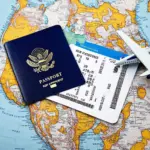“A total solar eclipse… is a cosmic mugging of the Sun!” That’s how astronomer Tyler Nordgren humorously described this celestial spectacle. And just like a rare gem, a total solar eclipse draws crowds from all corners of the globe. But how many people are actually packing their bags and traveling to witness this awe-inspiring event?
The Great American Eclipse: A Case Study in Eclipse Tourism
The 2017 “Great American Eclipse” offers a fascinating glimpse into the power of eclipse chasers. An estimated 7 million people flocked to the path of totality, a 70-mile-wide band stretching across the continental U.S. where the moon completely obscured the sun.
Imagine the scene: Small towns like Madras, Oregon, with a population under 7,000, swelled to over 100,000 as eclipse enthusiasts set up camp, transforming the landscape into a sea of telescopes and solar glasses. Hotels were booked solid months in advance, and highways were jammed with travelers eager to witness the celestial show.
 Eclipse viewers in Madras, Oregon
Eclipse viewers in Madras, Oregon
Predicting the Eclipse Exodus: It’s All Relative (Astronomically Speaking!)
While the 2017 eclipse provides a benchmark, predicting the exact number of travelers for future events is tricky. Several factors influence the scale of “eclipse tourism”:
- Visibility: A total solar eclipse visible over densely populated areas naturally attracts larger crowds.
- Accessibility: Easy access to the path of totality, such as major roads and airports, plays a significant role in travel decisions.
- Cultural Significance: Some eclipses hold special significance for certain cultures, drawing pilgrims and tourists alike.
For instance, the upcoming total solar eclipse on April 8, 2024, will cut across Mexico, the United States, and Canada. Given its accessibility and the anticipation surrounding this event, experts predict a surge in travel, potentially even surpassing the numbers witnessed in 2017.
Planning Your Eclipse Adventure: Tips from TravelCar.edu.vn
Witnessing a total solar eclipse is an unforgettable experience. If you’re planning to join the ranks of eclipse chasers, consider these travel tips:
- Book Accommodations Early: Due to high demand, secure your accommodation well in advance, exploring options beyond the path of totality.
- Factor in Travel Time: Anticipate heavy traffic and potential delays, especially as you get closer to the day of the eclipse.
- Prepare for All Weather: Pack for a range of weather conditions, as eclipses can cause sudden temperature drops.
- Embrace the Experience: Soak in the atmosphere, connect with fellow eclipse enthusiasts, and create lasting memories.
 Total solar eclipse over a city
Total solar eclipse over a city
FAQs: Unraveling the Mysteries of Eclipse Travel
Q: Do I need special glasses to view a solar eclipse?
A: Yes! Never look directly at the sun, even during an eclipse, without proper eye protection. Special eclipse glasses or solar viewers are essential to protect your eyes from serious damage.
Q: How long does a total solar eclipse last?
A: The duration of totality, when the sun is completely covered by the moon, varies depending on the eclipse. However, the maximum duration is typically around 7 minutes.
Q: Can TravelCar.edu.vn help me plan my eclipse trip?
A: Absolutely! TRAVELCAR.edu.vn offers a wealth of resources for planning your eclipse adventure, from destination guides and accommodation options to travel tips and safety advice. Check out our articles on specific eclipse destinations, such as “How Many People are Traveling to Ohio for the Eclipse?” for more detailed information.
The Allure of the Cosmos: Why We Chase Eclipses
In the tapestry of human history, eclipses have evoked a sense of wonder, awe, and even fear. Today, we understand the science behind these celestial events, yet their power to captivate remains undimmed. Perhaps it’s the fleeting nature of totality, the dramatic shift from daylight to twilight, or the ethereal beauty of the sun’s corona that draws us in.
Whatever the reason, one thing is certain: the allure of the cosmos, embodied in the spectacle of a total solar eclipse, will continue to inspire awe and draw travelers to witness these rare and breathtaking events for generations to come.

